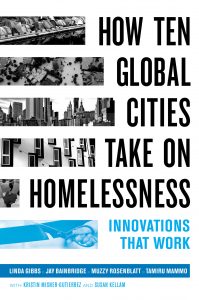In How Ten Global Cities Take On Homelessness: Innovations That Work, Linda Gibbs, Jay Bainbridge, Muzzy Rosenblatt and Tamiru Mammo explore some of the key challenges faced by urban spaces in tackling homelessness and outline the successes of ten global cities when it comes to addressing its causes and consequences. This book is a valuable resource that not only identifies the multiple governance and practical issues involved in solving homelessness, but also provides specific examples and evidence from many different settings about what can be done to overcome it, writes Gerald Koessl.
How Ten Global Cities Take On Homelessness: Innovations That Work. Linda Gibbs, Jay Bainbridge, Muzzy Rosenblatt and Tamiru Mammo. University of California Press. 2021.
 ‘Homelessness as an issue is itself homeless.’ This statement in Linda Gibbs et al’s exploration of How Ten Global Cities Take on Homelessness neatly sums up some of the key challenges addressed in the book, which are the many levels of governance between which homelessness sits. Policies which aim to tackle homelessness range from eviction prevention and landlord mediation to the provision of homeless shelters and mental health support. In addition, the definitions and causes of homelessness are extremely diverse.
‘Homelessness as an issue is itself homeless.’ This statement in Linda Gibbs et al’s exploration of How Ten Global Cities Take on Homelessness neatly sums up some of the key challenges addressed in the book, which are the many levels of governance between which homelessness sits. Policies which aim to tackle homelessness range from eviction prevention and landlord mediation to the provision of homeless shelters and mental health support. In addition, the definitions and causes of homelessness are extremely diverse.
The main concern of Gibbs et al’s book is street homelessness: that is, people who have nowhere else to live and sleep than the street. Whilst this is one of the key challenges many cities face today, the book makes clear that street homelessness is just the tip of the iceberg in the wider context of the housing crisis, including inequalities in neighbourhoods and discrimination against ethnic minority populations.
Homelessness services have gone a long way by shifting from hot meals and a bed only (‘Three hots and a cot’) to providing integrated services, which aim to address the underlying causes of homelessness. Crucially, it is not only homelessness services that have changed but also the nature of homelessness and the people affected by it. More recently, for example, homelessness is increasingly affecting ‘the working poor’: people in low-paid work or underemployment. In previous years homelessness has been on the rise across the globe, with a few notable exceptions. The issue has become particularly pressing in urban areas, including some of the major (global) cities discussed in this book. The book, however, takes a solution-oriented approach and effectively illustrates the challenges and, in particular, the successes of ten global cities in their fight against homelessness. These ten global cities are Bogotá, Colombia; Mexico City, Mexico; the US cities of Los Angeles, Houston, Nashville, New York City and Baltimore; Edmonton, Canada; Paris, France; and Athens, Greece.
Apart from the availability of affordable and suitable accommodation, a key concern in the fight against homelessness has been the question of how to get people off the street, in particular the chronically homeless. With many homeless persons having experienced mental health issues, trauma or other psychological issues, a move away from the street is often experienced as a ‘disruption’ rather than as a solution.
Continuous outreach work, relationship-building and the development of trust are therefore key in overcoming such obstacles. As the authors put it: ‘Outreach workers’ job is not to clear the streets of homeless people. Their job is to help homeless people leave the streets.’ One successful example of how chronic homelessness can be overcome are Safe Havens, found in cities like New York and Los Angeles. Safe Havens provide low threshold, (semi-) private rooms with additional services and less conditions compared to traditional homeless shelters. After having piloted in 2006, Safe Havens have proven successful in achieving positive outcomes, such as moving people to residential rehab, to a skilled-nursing facility or another place where they can get treatment to meet the client’s needs. Almost half of the people served achieved a positive outcome, which is significantly higher than in traditional shelters.
In addition to services that address the acute need for shelter and aim to get people off the street, other, more permanent solutions are of course needed to tackle homelessness. The authors make clear that while affordable housing strategies are key to tackling wider issues in the housing market, more chronic forms of homelessness require permanent supportive housing solutions.
A key milestone for supportive housing in the US – five of the studied cities are located there – was certainly the 1987 McKinney-Vento Homelessness Assistance Act, which provided the basis for more than 1 billion US dollars in funding for long-term services and facilities. The McKinney Act was also instrumental in the transformation of homelessness services in the US more widely. Instead of relying on volunteers and faith-based organisations, homelessness was increasingly regarded as a public policy issue, to be tackled via government-funded services. However, whilst publicly funded, the provision or administration of homelessness services often lies in the hands of non-profit organisations (at least in the examples given in the US and Canada).
The last decades have, however, not only seen a shift in the organisations providing supportive housing but also the people targeted by it. While the initial focus of supportive housing was on the chronic homeless, it is increasingly reaching out to other groups that are at risk of becoming homeless. Despite these changes, the main ambition of supportive housing remains the same: to provide affordable permanent housing with additional services. Housing First is a particular type of supportive housing for homelessness in that it makes permanent affordable housing available unconditionally: that is, without deeming people to be ‘housing ready’. One of the largest studies to assess the effectiveness of Housing First was undertaken in Canada. The project ‘At Home/Chez Soi’ demonstrated that people accessing Housing First schemes showed a higher rate of housing stability than in traditional (temporary) homelessness services.
However, the key to tackling homelessness in the long term, according to Gibbs et al, lies in a combination of preventative work, proper coordination of the various actors involved and determination to address the underlying factors that produce homelessness, including the (lack of a) welfare system, the shortage of affordable housing, domestic violence and (mental) health issues. The authors assign a critical role to evidence and an integrated use of data to combat homelessness, especially in terms of taking the right preventative measures and in targeting the right people.
Another key element to successfully tackling homelessness is systems-level thinking and a focus on coordinated strategic responses. Instead of thinking in silos, non-traditional partnerships between different actors and services are needed. Systems-level thinking, according to the authors, involves a set of principles ranging from effective leadership, having a shared vision and plan as well as the right governance structure and data-informed decision-making processes.
In terms of evidence and data, many cities do not even know the number of people sleeping rough. In order to address this shortcoming, Paris, for example, has started its first citywide street count in 2018, which was greatly supported by the community. Following a campaign, many volunteers participated in the count and helped gather valuable information about the state of homelessness in the French capital. In fact, the campaign was so successful that the city launched the ‘Factory of Solidarity’ (La Fabrique de la Solidarité) to harness public solidarity on the issue. The Factory of Solidarity has become an established resource centre where citizens can contribute to a wide array of activities to address homelessness, ranging from educational programmes for volunteers to participatory workshops or organising charitable acts (feeding stations, distributing blankets, etc). The Factory of Solidarity has helped steer citizen engagement in a direction that is aligned with the city’s community plan and steer them away from actions that may be well-intended but do not help to reduce homelessness.
In How Ten Cities Take on Homelessness, Gibbs et al provide a comprehensive picture of the multiple (often conflicting) governance and practical issues when it comes to tackling homelessness. The authors demonstrate that homelessness is not a problem that can be solved solely by providing shelter to those affected. What is instead needed is a rethink of the institutional setup and the systems and social structures that produce homelessness, including the welfare and juridical system, affordable housing policies and issues of domestic violence and discrimination. The book is a valuable resource for those interested in how cities have succeeded in tackling some of the causes and consequences of homelessness. It is surprising that the internationally recognised Housing First model is not given more space in the book. Despite this, it offers a refreshing hands-on contribution that not only identifies the problems around homelessness but, crucially, provides specific examples and evidence from many different settings about what can be done to overcome it.
Note: This article first appeared at our sister site, LSE Review of Books. It gives the views of the author, not the position of EUROPP – European Politics and Policy or the London School of Economics. Featured image credit: Jon Tyson on Unsplash



